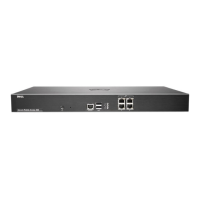Dell SonicWALL Secure Mobile Access 8.5
Administration Guide
169
13 Next, select the proxy authentication setting from the drop-down list. If Secure Mobile Access
authentication is enabled, select Basic Authentication.
14 Click OK to save the configuration, and then exit out of Microsoft Outlook.
15 Open Microsoft Outlook to start a new session. Log messages are generated when the Outlook Anywhere
portal is accessed.
Portals > Domains
This section provides an overview of the Portals > Domains page and a description of the configuration tasks
available on this page.
• Portals > Domains Overview on page 169
• Viewing the Domains Table on page 170
• Removing a Domain on page 170
• Adding or Editing a Domain with Local User Authentication on page 172
• Adding or Editing a Domain with Active Directory Authentication on page 174
• Adding or Editing a Domain with LDAP Authentication on page 177
• Adding or Editing a Domain with RADIUS Authentication on page 180
• Adding or Editing a Domain with Digital Certificates on page 183
Portals > Domains Overview
The Portals > Domains page allows the administrator to add and configure a domain, including settings for:
• Authentication type (local user database, Active Directory, LDAP, or RADIUS)
• Domain name
• Portal name
• Group (AD, RADIUS) or multiple Organizational Unit (LDAP) support (optional)
NOTE: If Authentication Control of the Secure Mobile Access portal is enabled, only Basic Authentication
can be supported. Be sure to select Basic Authentication on the Exchange server for Outlook Anywhere. If
Authentication Control of Secure Mobile Access is disabled, other authentication methods are supported.
NOTE: To provide better protection for the Exchange Server, anonymous Outlook Anywhere access is not
supported.

